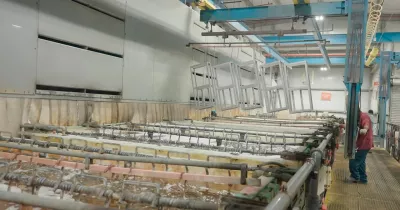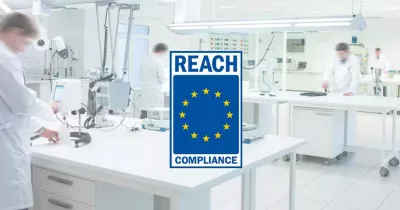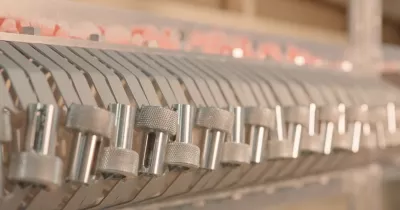ASTM B571 Explained: Why Adhesion Matters in Metal Plating

July 25, 2025
July 25, 2025
In metal finishing, a coating is only as good as its grip. If the deposit can’t stay put, corrosion creeps in, parts fail, and warranties become headaches. That’s why the industry leans on ASTM B571 – “Standard Practice for Qualitative Adhesion Testing of Metallic Coatings.” Below, we unpack what the standard is, how it’s used, and why adhesion should be the first (and last) thing you think about when plating metal parts.
What Exactly Is ASTM B571?
ASTM B571 is a collection of straight-forward, qualitative tests that reveal whether a metallic coating is properly bonded to its substrate. It’s widely used for:
Production control – verifying that process parameters are dialed in before large runs.
Acceptance testing – confirming finished goods meet spec before they ship.
The standard itself doesn’t hand you a pass/fail thickness number. Instead, it shows you—often quite dramatically—whether the coating will peel, flake, or lift under real-world abuse.
When Does B571 Apply?
Because the tests are simple and inexpensive, they’re staples in automotive, aerospace, electronics, heavy equipment and consumer hardware. They work on a broad range of coatings and base metals, though certain thicknesses or brittle layers may require extra care or alternative tests.
The Test Line-Up
ASTM B571 supplies a toolbox of methods. Pick the one that best mimics the stresses your part will face:
Bend Test – Bend the coated sample over a mandrel and inspect for peeling or flaking. Cracks alone aren’t a failure unless the film can be lifted with a blade. Perfect for stampings or parts that will be formed later.
Burnishing Test – Rub the coating with a hard object (typically an agate burnisher). Detachment indicates poor adhesion. Useful for decorative or soft deposits.
Chisel–Knife Test – Score the surface with a chisel or knife and attempt to lift the coating. Suited to thick or tough layers where simple bending isn’t practical.
Draw Test – Form a deep-drawn cup from coated sheet stock, then check for separation. Ideal when the final part will undergo forming operations.
File / Grind-Saw Test – Abrade through the coating with a file or saw and watch for lifting at the edge. Common for very hard, thick deposits such as hard chrome.
Heat-Quench Test – Heat the part, quench it, and look for blistering or peeling; great for components that will see thermal cycling.
Impact / Push Test – Strike the surface with a punch or ball, then examine the coating around the dent. Mimics shock loads.
Peel or Tape Test – Apply adhesive tape, pull sharply, and note any detached coating. A fast, all-purpose screening method.
Scribe-Grid Test – Cut a hatch pattern through the coating, apply tape, and count the squares that lift—commonly used on painted or powder-coated metals.
Tip: If your actual part is too large, small, or oddly shaped to test, run companion panels made from the same material and processed in the same bath.
Adhesion as a Reflection of Your Process
Adhesion failures are rarely isolated events. In most cases, they reflect a breakdown in surface preparation, plating chemistry, or post-treatment. At PAVCO, we see adhesion not as an outcome, but as a process-controlled property—one that begins before the first ion is deposited.
Surface Preparation (Pre-Plate)
If a substrate isn’t properly cleaned, no coating will bond well. Oils, oxides, and residues prevent the metal from forming a metallurgical bond with the deposit.
PAVCO’s pre-treatment technologies—such as Clean-R™ for degreasing, PavPrep™ LF for acid activation, and PavHib™ for hydrogen control—ensure surfaces are optimally prepared, reducing the risk of weak or inconsistent adhesion.
Plating Process Control
The chemistry and operating conditions of the plating bath—pH, temperature, agitation, current density—directly influence the deposit’s structure, stress level, and adhesion.
Using stable formulations like SmartZinc™ Premier or HyPro™ systems, which are engineered for high efficiency and minimal internal stress, improves deposit integrity and reduces the likelihood of peeling under mechanical or thermal loads.
Material Compatibility
Adhesion also depends on the compatibility between the base metal and the plated metal. Poor lattice matching or the formation of brittle intermetallic compounds can weaken the bond. Understanding these material interactions is essential, and PAVCO’s technical team works closely with customers to optimize bath chemistry for complex substrates and alloy requirements.
Post-Plating Stability
Post-treatments such as passivation, baking, or sealing can significantly impact adhesion if not properly managed. For example, baking parts after electroplating to reduce hydrogen embrittlement must be carefully controlled, as excessive heat or improper timing can degrade the bond.
PAVCO’s HyProCoat™ and HyProTec™ post-treatment technologies are designed to maintain adhesion performance while improving corrosion resistance and finish durability.
Reading the results

Alt Tet: Perfect adhesion occurs when the bond between the coating and the substrate is stronger than the internal strength of either material. In real-world terms, nothing detaches—no matter how forcefully you bend, peel, or strike the surface.
Failure is indicated by any visible signs of peeling, flaking, or blistering. Even if multiple tests are used, failing just one means the coating doesn’t meet the standard.
It’s also important to recognize gray areas. Because these tests are qualitative, results near the borderline can be open to interpretation. That's why it's essential for all parties to agree ahead of time on what constitutes acceptable adhesion for a given application.
Final Thoughts
Adhesion testing through ASTM B571 is more than a quality control step—it’s a reflection of how well your process is working, from pre-treatment through plating to final finish. When your chemistry is optimized, your surface is prepared, and your process is consistent, adhesion follows naturally.
At PAVCO, we help you build that consistency through every stage of the plating process. Our integrated chemistries for pre-plate, plating, and post-plate applications are designed not only for compliance—but for coatings that endure, perform, and stand up to the real world.
Need help improving adhesion in your plating line? Contact a PAVCO technical expert to evaluate your current process and explore advanced chemical solutions that enhance reliability and reduce failure rates.
IT’S HOW YOU FINISH

We’re a developer and supplier of chemistries for the metal finishing industry since 1948.
In PAVCO, we develop products and deliver services of the highest quality at a reasonable cost.







